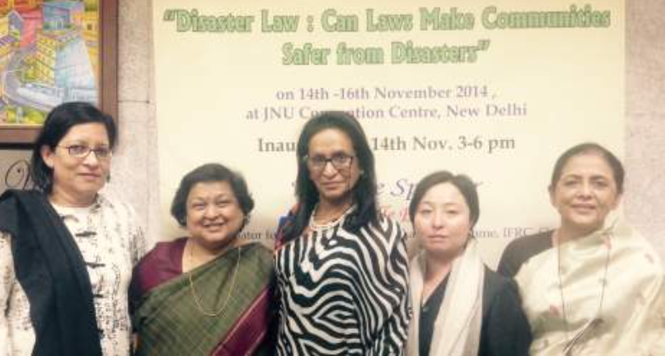
South Asia accounts for 23% of the world’s population and 40 % of the world’s poor people. It is also one of the world’s most disaster-prone regions. India alone suffers 2% of GDP losses due to disasters every year and that is not to speak of the countless communities that face floods, droughts, landslides and other calamities on a daily basis. For this very reason, the Jawaharlal Nehru University (JNU) in Delhi, India, recently hosted a three-day workshop to examine, if and how, laws can make communities in South Asia safer in disasters.
Over one hundred participants, a mix of representatives of governments, including the judiciary, academia, the UN, IFRC and civil society from across the region came together to look at the role law should play during a disaster, and how it can be better utilised to both improve preparedness and reduce risk from disasters at the community and institutional levels. Laws that empower community action and participation were seen as essential to move the disaster discourse from one of relief to development. While it was recognised that law cannot solve the many issues alone, it was seen as an important pillar to both institutionalise best practices and provide a mechanism for accountability.
Professor Santosh Kumar, Director of the Disaster Management Centre for the South Asian Association of Regional Cooperation, remarked that regulating and reducing risk form disasters was not new to South Asia. In this respect, he made reference to the codification of such practices right back to the writings and teaching of Kautilya (in 300BC). However, the focus on disaster management legislation, in the more recent history of India and wider South Asia had become more focused on relief and emergency response. Professor Kumar made a strong call for a more holistic and inclusive approach to law making, including the need for the whole of government, including the judiciary, to be institutionally prepared to operate in times of disaster.
Retired Sri Lanka Supreme Court Justice Shiranee Tilakawardane, emphasized that the law can be used as a tool to empower the most vulnerable in times of disaster since “when a mass disaster occurs, those who have been affected often lose their dignity and independence and thus become dependent. In this scenario, what is important is to sustain what the law guarantees and that is equality for all.” During the 2004 Indian Ocean Tsunami, she saw first-hand how pre-existing vulnerabilities in Sri Lankan communities were compounded. This was evidenced by the transfer of land titles from women to male relatives in the post disaster chaos, as women were often not able to make the long and costly trip to court to retain the land ownership. She emphasised that the law, “must be designed to empower and protect the most vulnerable, such as women and children and those with disabilities before and after disaster strikes.”
The workshop was the brainchild of Professor Amita Singh, Professor of Law and Governance at JNU who has been active in the establishment of the Disaster Research Programme at the University. The Disaster Research Programme was launched in June this year and brings together a collaboration of seven centres at JNU from a range of disciplines, with the realisation that a multi-disciplinary approach is required in order to reduce vulnerabilities and risk to disasters. JNU will be continuing its active research in this area, with the support of IFRC, and hopes to publish a book on the outcomes of the workshop including recommendations on how to strengthen disaster law frameworks in India.
In the photo attached: from left to right Ms Farah Kabir (Action Aid Bangladesh); Justice Gita Mittal (Delhi High Court); Justice (Rtd) Shiranee H. Tilakawardane (Sri Lanka Supreme Court); Ms Chio Moechiba (UNESCO); Professor Amita Singh ( Jawaharlal Nehru University, Delhi)